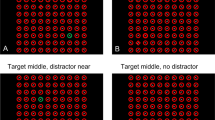Abstract.
There is a debate about how task-irrelevant visual distractors influence motor responses. Inconsistent findings in previous studies may reflect the use of different spatial layouts. In this study, participants pointed to randomly lateralized targets under full viewing conditions, either with or without a single distractor present. Distractor location, size, and spacing from the target were systematically manipulated while target size and movement amplitude remained constant. Larger distractors facilitated reaction times and slowed movement times. Distant distractors facilitated only reaction times. Movement endpoints were biased away from distractors. The single distractor also modulated perceived target size. These results are discussed in the context of current theories of the role of visual perception for action control.
Similar content being viewed by others
Author information
Authors and Affiliations
Additional information
Electronic Publication
Rights and permissions
About this article
Cite this article
Fischer, M., Adam, J. Distractor effects on pointing: the role of spatial layout. Exp Brain Res 136, 507–513 (2001). https://doi.org/10.1007/s002210000596
Received:
Accepted:
Issue Date:
DOI: https://doi.org/10.1007/s002210000596




